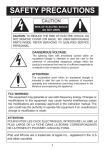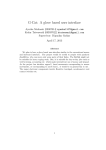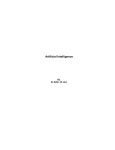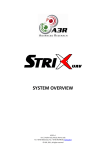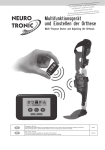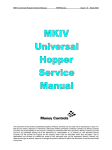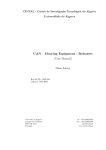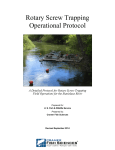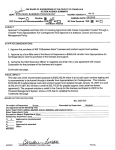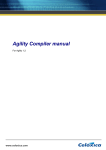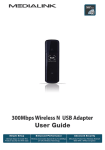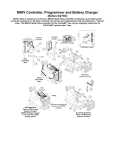Download Coded Wire Tagging Operations Protocol for Chinook Salmon in the
Transcript
Coded Wire Tagging Operations Protocol for Chinook Salmon in the Stanislaus River A Detailed Protocol for Coded Wire Tagging Operations on the Stanislaus River at Caswell State Park Prepared for: U.S. FISH & WILDLIFE SERVICE & U.S. BUREAU OF RECLAMATION Prepared by: Ayesha Gray, Ryan Cuthbert & Brad Cavallo Copyright © 2007 by Cramer Fish Sciences Cramer Fish Sciences • 636 Hedburg Way, Suite #22 • Oakdale, CA 95361 • (209) 847-7786 • www.fishsciences.net Code Wire Tagging Protocol at Caswell State Park Table of Contents I. Introduction............................................................................................................. 1 II. References.............................................................................................................. 1 III. Setup........................................................................................................................ 1 A. Water and Power Setup...................................................................................... 1 B. T4 Detector Setup............................................................................................... 2 C. Mark IV Injector Setup........................................................................................ 2 IV. Final Check.............................................................................................................. 4 V. Daily Operations..................................................................................................... 4 A. Half Length Coded Wire Tags (35–60 mm)......................................................... 4 B. Sequential Decimal Coded Wire Tags (> 60 mm)............................................... 5 VI. Breakdown............................................................................................................... 6 VII.Maintenance............................................................................................................ 7 A. Disinfecting Equipment........................................................................................ 7 B. Mark IV Injector................................................................................................... 7 C. T4 Detector.......................................................................................................... 7 Appendix 1: T4 Assembly............................................................................................. 9 Appendix 2: Disassembling and Cleaning the MKIV................................................ 10 Appendix 3: Coded Wire Tagging Data Sheets......................................................... 11 Code Wire Tagging Protocol at Caswell State Park I. Introduction The following protocol describes the procedure for coded wire tagging operations on the Stanislaus River at Caswell State Park including set up and equipment operation and maintenance, determining tag depth and placement, tagging, fish handling, release, and mortality/tag retention studies. Refer to the Detailed Study Plan for Coded Wire Tagging for additional information about the project. II. References Refer to the T4 Detector User’s Manual, Mark IV Instruction Manual and Coded Wire Tag Project Manual for additional information from Northwest Marine Technology (NMT) regarding use and setup of equipment. These manuals can be found on the NMT website: http://www.nmt.us/support/manual.htm. III. Setup When the trailer is used at a remote site (i.e., away from a hatchery or other facility providing electricity and security), it will be necessary to set up power (generator), water (pump from the river), marking equipment, fish holding tanks, etc., on a daily basis. At the end of the day, equipment will need to be put away and secured. Note: Generator, water pump, hose connections and T4 Detector will all be stored within the tagging trailer when not in use. A. Water and Power Setup 1. Position generator. Generator should be positioned several meters away from the T4 Detector as a magnetic field created by generator may cause false positives by T4 Detector. Take care to insure generator exhaust does not enter the trailer, and generator is clear from all potential fire hazards like dry grass or brush. Connect red extension cord between trailer service panel and generator. Figure 1. Water pump setup. 2. Connect water pump. Remove water pump and hose connections from trailer. Check water tightness of water pump cord. Station water pump (Figure 1) and attach hoses to trailer (Figure 2). Plug water pump into generator. 3. Start generator. As generator starts, check water flow and supply inside and outside trailer. Check water pressure inside trailer and make sure sinks do not overfill. Adjust water pressure at sink valves, if necessary. Water flow will fill inside and outside holding tanks. Make sure tanks do not overfill. Figure 2. Hose attachments to CWT trailer. Blue hose delivers water from pump; green hose delivers internal freshwater overflow back to river. 4. Prepare Tricaine-S (dope) water. Fill red tank to within 2 inches of top (~15 gallons) (Figure 3). Add 1 tsp. of Tricaine-S powder to red tank and stir. Check pH with paper and add 1–1½ tsp. baking soda as needed to achieve neutral pH (7). Prime small water pump with water from tank and plug into outlet above sink. Pump will start, re-circulating dope water. Open sink valves and fill sinks; check pressure at sink valves, and do not overfill. Figure 3. Red (Tricaine-S water) tank. 1 Code Wire Tagging Protocol at Caswell State Park B. T4 Detector Setup 1 Position T4. Attach extender to fish outfall and position assembled T4 (See Appendix 1 for assembly) under water flow and above holding tank (Figure 4). Adjust leg height so top edge of funnel is parallel to ground and at correct height for fish outfall. (Water from fish outfall is sufficient to move fish through T4, however a hose attachment is located under the funnel if additional flow is required.) Add a fish live-car under the right side of the diverting gate to catch unmarked fish. Marked fish should fall into holding tank. Adjust flow so fish are sliding easily through tunnel and water coming out back of detector is hitting surface water of holding tank about 30 cm from end of tunnel. 2. Attach power supply and cords. The two 8-pin connectors are Figure 4. T4 positioned between fish outfall of identical on the T4 Detector and control box (Figure 5). The uni- trailer and holding tank. versal cables are also identical at each end. To insure good electrical contact and waterproof assembly: 1) gently push and rotate plug in connector until plug hits connector pins; 2) push plug as far into connector as it easily goes; and 3) turn locking ring a half turn while continuing to push until ring and connector are firmly attached. Note: Make sure cables and connectors are dry before attaching, and close dust covers when not in use. • Connect cord from control box to T4 • Connect cord from control box to diverting gate • Connect cord from T4 to power supply 3. Power the T4. The DeWalt battery pack or 24-V DC power Figure 5. T4 control box displaying the identisupply can be used to power the T4. Slide the on/off switch on cal 8-pin connectors. Alarm volume can be conbattery pack to the “on” position. The green power ON Led will trolled using duct tape (red arrow), which can light. Charge the battery pack for 8 hours before use for maximum be removed so alarm is heard inside the trailer. capacity. When using the 24-V DC power supply, plug into the 3-prong outlet on generator. Note: The cord is glued into the power supply, so please do not try to remove it. 4. Check T4 function using detection standard. The detection standard (a CWT on the end of a stick) can be used to verify T4 is detecting tags, determine range of speeds a tag is detected, and to make sure live-car is positioned under the correct side of the diverting gate for catching unmarked fish. Note: When T4 detects a tag the diverting gate will open moving tagged fish into holding tank or live-car. C. Mark IV Injector Setup 1. Setup MKIV. Place MKIV at each tagging station above round sink. Attach power supply to small connector at rear of MKIV, run cord through ceiling hooks and plug into AC outlet on wall. Note: The MKIV has an internal breaker and protective fuse which will turn off the MKIV when tripped. After 1 minute, the breaker will reset unless the protective fuse has blown, in which case NMT servicing is required. Attach touch switch to either of the large connectors at rear of MKIV. Keep the protective caps on connectors when not in use. Make sure appropriate head mold is on machine for size of fish and it is in proper position with sides parallel to ground and head mold cup up (Figure 6). 2 Code Wire Tagging Protocol at Caswell State Park 2 Turn on MKIV. Power MKIV by pressing rubber-covered on/ off button on back of MKIV. The MKIV will show the message “NO QCD OK?” Press [OK] on keyboard to confirm and clear message, as we are using a T4 Detector instead of a in-line QCD. The “READY V7.0” message. 3. Inspect tagging needle. Press [SHOW] on keypad and examine needle with magnifier. Make sure it is sharp and smooth, and the needle position is correct with bevel angled up. After inspection, retract needle by hitting [ESC] on keypad. 4. Engage rollers. Open latch on front of MKIV and swing open door. Find lower drive roller arm and move lever to engage Figure 6. Headmold positioned on Mark IV rollers (Figure 7). Note: Rollers should always be left disengaged tag injector. after use. 5. Load tag wire. Put the MKIV in Load mode by pressing [LOAD] on keypad. This will disengage motor drive. Remove the label on one side of the tag wire and attach to datasheet for sampling week. Add spool and thread tag wire through rear wire guide until it reaches drive rollers. Rotate roller clockwise by hand to feed wire into front wire guide. Use hemostats from tool kit to start wire into forward guide. Re-engage rollers and turn top roller clockwise until tag wire extends slightly beyond top of the head mold. Press the [ESC] key. The MKIV will be in Tag mode. Press [TAG] on keypad once to cut extra tag wire. MKIV is now ready to operate. Figure 7. Internal parts of the Mark IV injec- tor including the green drive rollers and drive 6. Check tag placement. To set penetration put MKIV in roller arm (red arrow). [SHOW] mode which will move needle to its fully extended position. Loosen set screws on head mold and slide head mold in or out to adjust distance needle will extend into specimen. Gently tighten set screws to hold head mold in place. Note: Correct placement for the commonly used head molds will be marked by pencil or waterproof marker. Tag placement can be confirmed (in very small fish, 35–40 mm) by opening the mouth and looking ventrally through the nose. 7. Tag fish and check placement. Tag should appear centered in the sinus cavity of the small fish (Figure 8). If tag is too deep move the head mold out slightly. If tag is too shallow move the head mold in slightly. These movements need to be very fine; small differences (e.g., 0.5 mm) can be extreme in small fry. Repeat procedure until ideal tag placement is achieved. Mark position on head mold with pencil or waterproof pen, so approximate position of head mold is known the next time tag placement is set. Note: Setting tag placement in larger fish is done the same way, however the margin for error is larger. 8. MKIV is ready to mark fish. Figure 8. CWT in Chinook salmon fry 3 Code Wire Tagging Protocol at Caswell State Park IV. Final Check 1 Check temperature and Dissolved Oxygen (DO). Make sure temperature of both fresh water tanks and dope water ranges from 10–19 °C (50–65°F) and check dissolved oxygen with DO meter. Dissolved oxygen should be at 95% saturation. Dope water temperature can be lowered, if necessary, by adding frozen water bottles. If DO is low, add an aerator to holding tanks to increase oxygen levels. 2. Check flow. Make sure all sinks have adequate flow to move fish through pipe system without too much splash and spray on MKIVs. V. Daily Operations A. Half Length Coded Wire Tags (35–60 mm) 1. Each day’s fish are transferred to trailer’s internal holding tank (Figure 9) from screw trap live-box using buckets. 2. Each tagger will record and monitor water conditions at their station, including water temperatures, dissolved oxygen saturation and time to sedation. Each water sink has a digital thermometer to constantly monitor water temperature. 3. The tagger will take small groups of fish (~10 individuals) from internal holding tank with dip nets. Fish will be put into net baskets and placed in dope water sink at a tagging station when tagger is ready to begin marking. 4. Fish will be anesthetized after 2–5 minutes. When fish reach sedation and exhibit loss of equilibrium, marking will begin. If fish are in dope water longer than 5 minutes they can be transferred to adjacent fresh water sink to recover. Figure 9. CWT trailer’s internal holding tank 5. Carefully pick up fish, cradling head between thumb and index finger. Position fish so adipose fin is resting on middle finger (Figure 10). Use surgical scissors to cut off adipose fin being careful not to cut fish or other fins. Note: Be sure to remove at least 50% of the adipose fin to prevent later regrowth. 6. Position fish upside down in head mold (be sure proper size head mold is being used). When fish is secure and firmly, but gently, pressed against MKIV, push tagging button. Make sure the fish’s head stays firmly against the tagging machine while tag is placed and does not move away from machine (Figure 11). Figure 10. Cutting adipose fin with surgical 7. After fish is tagged, place in round sink below tagging machine. scissors Make sure water pressure is sufficient to move fish efficiently through pipes. Fish will travel down pipe and exit trailer into T4 Detector. Fish will be counted, if tagged, as it moves through T4 Detector and will be deposited into external holding tank. Untagged fish will be diverted by T4 Detector into live-car in external holding tank. Fish from live-car should be retrieved, re-anesthetized and re-tagged. Note: Do not attempt to tag any fish more than twice. If tagging fails twice, fish will be released untagged. 4 Code Wire Tagging Protocol at Caswell State Park 8. Tagged fish will recover in external holding tank for at least one hour. Make sure tank is fully shaded and water temperatures are low (i.e., less than 16°C (60°F)). After all the day’s catch are tagged and have recovered in external holding tank, fish will be carefully counted (manually) and the number of fish tagged will be compared to number as counted by T4 and batch count on each MKIV. Press [BATCH] on keypad to display number of fish tagged at each station. Record each number (T4, MKIV and manual count) on data sheet. MKIV will display “OK TO CLEAR COUNTS?” so press [OK] to clear. 9. Estimates of tag retention and mortality will be determined with Figure 11. Tagging juvenile Chinook with MKIV a sub-sample of tagged fish. Retrieve 3% of tagged fish after each tagging session and put them in a net pen in a protected location in the river. Label marking tape on net pen with date, number of fish, batch code number, location and purpose (tag retention and mortality, or efficiency release). After 24 hours, check the net pen, remove all fish and count. Record the number of mortalities on data sheet. Run all fish (live and dead) through T4 Detector and determine number of tagged and untagged fish. Record number of tagged and untagged fish on data sheet. Label and bag all mortalities, and return to the office freezer. If fish are released at night, a night crew will also check for mortalities and record any additional mortalities on data sheet. Mortalities and tag retention numbers will be reported to Jason Guignard (CDFG) each week. 10.Tagged fish may be held in river net pens until nighttime release (or released immediately after QC). Tagged fish will be released below trapping site into the river in small groups to avoid predation. Releases of marked fish to determine trap efficiency may also use tagged fish. B. Sequential Decimal Coded Wire Tags (>60 mm) 1. Fish greater than 60 mm will be marked with sequential tags. One marking station will be dedicated to tagging larger fish with sequential tags. A larger head mold will be used for these fish. Larger fish will be segregated from day’s catch and held separately from fish marked with half length tags. 2. Processing and marking area will be setup to achieve the maximum efficiency of process. Each tagger will follow instructions detailed above regarding water conditions, marking small groups of fish at a time, Tricaine-S exposure, etc. 3. Before marking begins, the initial sequential tag will be ejected from the MKIV, read with the Magni-viewer (Figure 12), taped to the datasheet and tag number recorded on data sheet (see Appendix 3). If fish are to be individually marked, flanking tags (initial and final) will be ejected, and taped to the datasheet. These tags will be read with the Magni-viewer after completion of day’s tagging (to avoid slowing the tagging process), and tag numbers will be recorded on datasheet. If fish are to marked in daily batches, Figure 12. NMT Magni-viewer (top) used after initial tag is ejected and read, fish are tagged, then final to read sequential tags (bottom) tag is ejected, read and saved. Initial and final tag numbers are recorded on datasheet. 5 Code Wire Tagging Protocol at Caswell State Park 4. After fish is tagged, place in round sink below tagging machine. Make sure water pressure is sufficient to move fish efficiently through pipe. Fish will travel down pipe and exit trailer into T4 Detector funnel. Fish will be counted, if tagged, as it moves through T4 Detector and will be deposited into external holding tank. Untagged fish will be diverted by T4 Detector into live-car in external holding tank. Fish from live-car should be retrieved often, re-anesthetized and re-tagged. Note: Do not attempt to tag any fish more than twice. If tagging fails twice, fish will be released untagged. 5. Tagged fish will recover in external holding tank for at least one hour. Make sure tank is fully shaded and water temperatures are low (i.e., < 16°C (60°F)). After all the day’s catch are tagged and have recovered in external holding tank, fish will be carefully counted (manually) and the number of fish tagged will be compared to number as counted by T4 and batch count on each MKIV. Press [BATCH] on keypad to display number of fish tagged at each station. Record each number (T4, MKIV and manual count) on data sheet. Press [CLEAR] and MKIV will display “OK TO CLEAR COUNTS?” so press [OK] to clear. 6. Fish tagged with sequential tags will be held for tag retention and mortality estimates separate from fish tagged with half-length tags, so tag retention and mortality estimates are specific to tag type. Follow instructions above for holding and releasing fish. VI. Breakdown 1. Flush all sinks with 5 gallons of river water to make sure all tagged fish are in the external holding tank. After flushing tanks, empty dope water on to ground at least 20 meters away from river using the small water pump and a hose. Turn on water and pump all dope water out of red tank. Note: Do not dump large amounts of water on dike road. Please make sure it is drained well off the side. 2. Fill a couple of buckets with water to be used in cleaning trailer floor, then shut off generator. Use mop and squeegee to clean floor of trailer. Sinks and tabletops will be wiped clean with dilute bleach solution. MKIV tagging button and power supply will be disconnected and stored, and MKIV will be cleaned after each use following instructions in Appendix 2. Make sure all supplies and equipment are stored properly. Let generator cool outside before putting in trailer. 3. Once a week floors will be thoroughly mopped with disinfectant (dilute bleach solution). 4. T4 Detector will be shut off, cords detached and dried. T4 tunnel and funnel will be cleaned using dilute bleach solution and paper towels. Make sure caps on connectors are dry and closed. Store T4 inside trailer. 5. Neatly stack all hoses inside trailer. Generator, water pump, T4 Detector will be placed carefully in trailer. 6 Code Wire Tagging Protocol at Caswell State Park VII. Maintenance A. Disinfecting Equipment Equipment should be cleaned and disinfected at the end of each tagging session. (See Appendix 2 for additional photos and instructions for cleaning the MKIV.) B. Mark IV Injector 1. Wipe down exterior surfaces of MKIV with a damp paper towel, including the touch switch, cords and power supply. 2. Wipe marking counter with dilute bleach solution. Make sure all outlets are capped on MKIV and wipe all exterior surfaces with bleach solution. 3. Remove head mold and wipe clean with bleach solution. DO NOT USE ALCOHOL ON HEAD MOLDS. 4. Open MKIV, and remove tagging needle, needle carrier, clamping nut and dismantle the cutter (Figure 13; see also Appendix 2). Place in container and cover with bleach solution. Remove head mold positioning screws and place with tools in same solution. Figure 13. Technician removing the cutter bar. With the alcohol spray bottle, wet and clean the interior surfaces. Carefully clean all surfaces and tubes, and shift parts to make sure cleansing agent reaches all surfaces. 5. Spray alcohol solution on electrical outlets, caps, connections of power supply and touch switch, and allow to dry before replacing caps. 6. Dry soaking injector parts, and wipe down tools and other equipment in tap water. Remove any debris (CWT tags) attached to cutter parts. 7. Use tag wire dipped in alcohol solution and probe holes in cutter to clean. Force a stream of alcohol through tagging needle with an alcohol-loaded syringe. Reassemble parts using disinfected tools. C. T4 Detector 1. Unplug power and beeper cables from back of detector and put caps over connectors before washing with dilute bleach solution. Be sure connectors are dry before closing caps. 2. Remove power supply and wipe dry. Wash tunnel, gate and fish funnel thoroughly to remove scales and fish slime. 3. To disinfect the T4, wipe clean with dilute bleach solution. 7 Code Wire Tagging Protocol at Caswell State Park 8 Appendix 1: T4 Assembly 1. Unfold legs and extend. 4. Attach diverting gate, fit pins to holes, clip to T4. 2. Clip T4 onto pins at lower end. 5. Attach funnel, fit pins to holes and clip to T4. 7. Attach control box with wing nuts and screws above funnel. 6. Assembled T4. 8. Universal cords are used to connect components. 10. Fully assembled T4 with battery power pack. 3. Fit high end into grooves and secure with clips. 9. Turn locking ring to attach cords; place duct tape over bell to reduce sound volume (optional). 11. T4 positioned under fish outfall at CWT Trailer. 9 Appendix 2: Disassembling and Cleaning the MKIV 1. Disengage black latch. 2 Open side cover. 3. MKIV Interior. 4. Unscrew top nut on cutter assembly with 7/64” hex wrench. 5. Hold and unscrew lower nut on cutter assembly. 6. Pull out cutter bar; use tag wire to check for stray tags. 7. Examine hole (with magnifier) for damage or wear. 8. Remove head mold with 1/16” hex wrench. 9. Carefully remove tagging needle. 10. Pull out needle and examine tip for damage or wear (with magnifier). 11. Unscrew needle carrier nut with 3/32” hex wrench. 12. Use hemostats to remove needle carrier. 13. Remove needle carrier and use tag wire to check for stray tags. 14. Clean head mold with bleach solution ONLY. 15. Clean interior of MKIV with alcohol and soak all internal parts in dilute bleach solution. 10 Temp MS (F) QC Crew Members Pretagging Morts # Overnight Morts # Released Untagged # Untagged # Sequential Tagged Efficiency Mark? Release Date Efficiency Mark? # Untagged Release Date # Half Tagged QC 2: # Tagged # Escaped # Tagged # Escaped QC 1: # Overnight Morts Sequential Tag QA/QC QC Crew Members Half Tag QA/QC Temp FW (F) # Held Overnight Tagging Crew Members # Released after Tagging End Time Appendix 3: Coded Wire Tagging Data Sheet Start Time General Information Date Comments: # Tagging Morts Half Tag Information Batch Code # Held Overnight Entered By: # Release after Tagging Sequential Tag Information Tag Code Range # Tagging Morts Field Check: 11 Appendix 3: Coded Wire Tagging Data Sheet (continued) Sequential Tag Information Page_____of _____ Date: Fish Number 12 Fish Length (FL mm) Fish Weight \(g) Initial Tag Final Tag Tag Code Notes/Comments 13 Copyright © 2007 by Cramer Fish Sciences


















